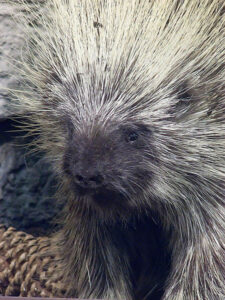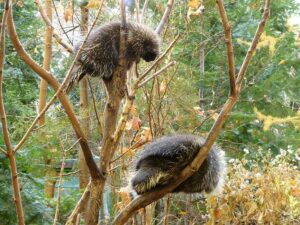The porcupine (Erethizon dorsatum), commonly known as “porky”, “hedgehog”, or “quill pig”, is a rodent second in size only to the beaver in Alaska. Its broad distribution covers nearly all of the state except the northern slope of the Brooks Range, the Seward Peninsula and the delta regions of the Yukon and Kuskokwim rivers, all basically treeless environments. Although they are generally found in coniferous forests, their distribution includes a wide range of vegetation types from semi-desert to tundra.
The peculiar pelage of the porcupine makes it unique among mammals of the Western hemisphere. The porcupine’s coat is comprised of a soft, brown, woolly undercoat and coarse long guard hairs. These guard hairs conceal the quills until the porcupine is aroused. The quills are longest on the shoulders and back and when raised push the guard hairs forward forming a crest. On the face the quills are about 1/2 inch long, on the back they may be up to 5 inches in length. These quills are stiff, filled with a foamlike core, and as many a dog owner knows are barbed like a fish hook at the tip. Overall, the porcupine has been estimated to have over 30,000 quills, so, it is not incapacitated by a single encounter with an enemy, when several hundred quills may be dislodged. As the quills are lost, they are replaced by new quills which are white, sharp but firmly anchored in the skin until they are fully grown. However, there are no quills on the muzzle, legs and underparts of the body, leaving it vulnerable to wolves, wolverines, lynx, foxes, bears and sometimes even owls which are their predators.
Despite the quills, porcupines are able to manage mating and birthing with no special problems. Porcupines first breed when they are one or two years old in late October to November. The female is only in heat for 8 to 12 hours and is often the one who begins courtship, which is no more elaborate than embracing and nose- rubbing before mating. Mating porcupines has been the subject of considerable jokes and speculation but the explanation is quite simple. The female flattens her quills and twists her tail out of the way and mating begins and finishes abruptly. The gestation period is about 30 weeks and the usually solitary baby may be born in a rock pile, under a log stump or a brush pile.
Little preparation such as a nesting den or a bed is prepared. The baby porcupine, called a porcupette, weighs between one to two pounds at birth and is born with its eyes open. The quills of a newborn porcupine are soft during delivery and harden within 1/2 hour of birth. By fall most young porcupines live apart from their mothers and for much of its life will lead a solitary existence. An adult porcupine can be up to 39 inches long, including a 9 inch tail, and will weigh between 15 to 28 pounds and have a life span of 5 to 7 years.
During winter the porcupine does not hibernate. However, they will spend a considerable amount of time in a tree (or under one) and usually will not move more than 100 meters from its winter den. During the lean winter season porcupines feed largely on the soft inner bark of trees, (the cambium layer). This can have disastrous consequences for the tree because the cambium carries moisture and minerals to leaves and branches. If they completely girdle the tree with their eating, the tree dies. As spring evolves porcupines will eat the leaves of herbs and shrubs along with the catkins of alder, poplar and willow and, being good swimmers, will graze on shallow water plants. One of the porcupine’s best known and least liked eating habits is that of chewing wood and leather in and about camps and homes. Both salty and non-salty objects are gnawed which indicates the habit may stem from not only a craving for salt but also a need to hone the continuously growing teeth. Perhaps a plywood that incorporates a porcupine repellent may someday be developed, surely, that would benefit many an outhouse here in Alaska! When man-made objects are not available, the porcupine will chew bones and cast-off antlers. Porcupine do have some beneficial eating choices too, mistletoe, a parasite on trees, is a favored food.
Being short-sighted and slow moving, the porcupine is a frequent victim on roadways, especially in winter when the snow is deep. Their tracks can be recognized by the firm print of the whole sole with long claw marks and sometimes marks where the tail has dragged. If the snow is soft and deep the porcupine trail becomes more of a trough through the snow. Athabascan Indians of the Interior still use porcupine quills to make beautiful earrings and other decorative items. The easiest way to collect quills (other than off a roadkill) is by lightly tapping a porcupine on its back with a piece of styrofoam and later removing the quills from the material. They don’t run very fast (more like a shuffle or waddle) and the myth that they “throw their quills” circulates because when attacked, a porcupine turns away from its tormentor and lifts the skin on its back, presenting the attacker with a forest of quills. Needless killing, or over-harvesting of quills should surely be discouraged. Porcupines are an integral part of the Alaskan faunal scene and have an important place in classic literature. Henry Wadsworth Longfellow wrote so eloquently in “The Song of Hiawatha” :
From a hollow tree the Hedgehog
With his sleepy eyes looked at him,
Shot his shining quills, like arrows,
Saying with a drowsy murmur,
Through the tangle of his whiskers,
Take my quills, O Hiawatha!
From the ground the quills he gathered,
All the shining little arrows…





